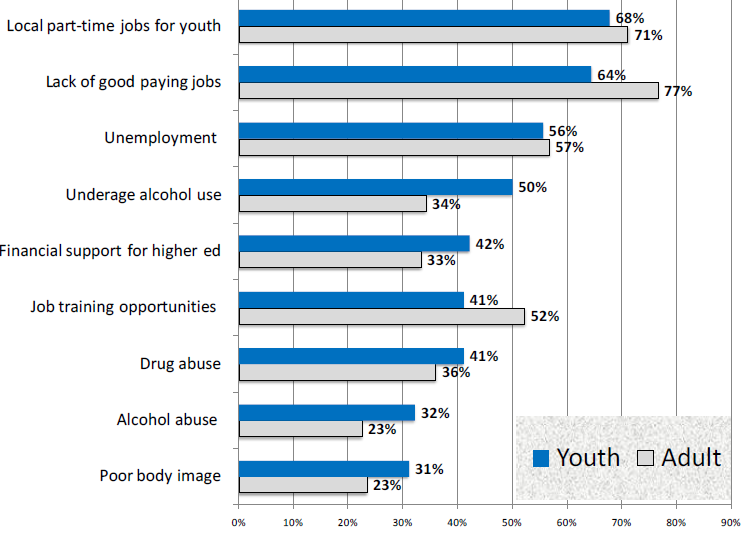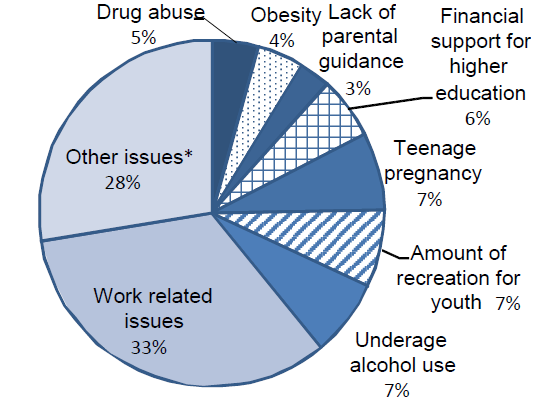Introduction
The Northeast Clark County office of the University of Nevada Cooperative Extension (UNCE) conducted a needs assessment of local high school students in January 2011. A needs assessment uses surveys to identify issues members of a community believe to be of concern. Needs assessment results assist UNCE with prioritizing efforts to address these issues through educational programming.
A needs assessment directed at the adult population was conducted for Northeast Clark County in 2010 (Bishop, 2010). This survey’s respondents (73 percent of the 340 participants) came from older residents without children at home. This highlighted a need for a targeted assessment to discover issues of importance to local youth.
Needs Assessment Process
The youth assessment included a sub-set of 50 of the 70 issues presented in the initial adult survey and was determined in coordination with Mr. Keith (Charlie) Cooper, civics educator. The survey focused on six major areas of interest which commonly exist across communities: youth, family, health and nutrition, community, economics and agriculture and natural resources.
The survey was offered to all senior civics students at Moapa Valley Empowerment High School in January 2011. Ninety students chose to participate in the survey.
Respondents indicated whether they felt the listed issue was not a problem, a small problem or a large problem in their community. The survey also asked what respondents perceived as the most important listed issue and what issues were important that were not listed in the survey.
Of the 340 adults who participated in the previous area-wide survey, 111 were from Moapa Valley. The youth responses were compared against these adult responses to determine possible differences or similarities between the perceptions of the two groups.
Major Issues
Major issues are defined here where 30 percent or more of the 90 youth respondents felt were large problems in their community. Nine major issues were identified by the survey and are listed in order of concern:
- Local part-time jobs for youth
- Lack of good paying jobs
- Unemployment
- Underage alcohol use
- Financial support after high school
- Job training opportunities
- Drug abuse
- Alcohol abuse
- Poor body image
Figure 1 details both the percentage of youth and adults that perceived the issue as a large problem.
Figure 1. Percentages of youth and adult respondents who consider the listed issue a large problem

Data From Figure 1
Youth Issues
Of the eight issues categorized as youth issues, the top two concerns for youth were financial support for education after high school and the amount of recreation available for youth. Youth and adults differed greatly on the percentage who considered teenage pregnancy to be a large problem. This may be due to interpretation of the question.
Table 1. Percentage of respondents who consider the listed youth issue a large problem
| Issue |
Youth |
Adult |
| Financial support for higher education |
42% |
33% |
| Amount of recreation for youth |
28% |
31% |
| Inadequate preparation of youth for work |
23% |
42% |
| Teenage pregnancy |
23% |
9% |
| Quality of education |
19% |
21% |
| Peer harassment (bullying, teasing, etc.) |
14% |
14% |
| After school & out of school programs |
9% |
26% |
| Dropping out of school |
7% |
15% |
Family Issues
Lack of values and/or respect for others was felt to be the largest problem related to the family, followed by lack of parental guidance. Youth were not as concerned with the number of activities for families as the adults were.
Table 2. Percentage of respondents who consider the listed family issue a large problem
| Issue |
Youth |
Adult |
| Lack of values/respect for others |
22% |
27% |
| Lack of parental guidance |
18% |
16% |
| Number of activities for families |
12% |
27% |
| Domestic violence |
9% |
13% |
| Family emergency preparedness |
9% |
14% |
| Physical, sexual or emotional abuse |
9% |
8% |
| Child abuse |
8% |
7% |
| Inadequate family counseling services |
7% |
14% |
Health and Nutrition Issues
Underage drinking is the dominant health concern along with substance use and abuse, which comprised four of the top five issues. Additionally, a much larger percentage of youth than adults felt these issues were large problems. Poor body image concerned a larger percentage of youth than did obesity, lack of fitness programs and overall health and fitness. The reverse was true for adults.
Table 3. Percentage of respondents who consider the listed health & nutrition issue a large problem
| Issue |
Youth |
Adult |
| Underage alcohol use |
50% |
34% |
| Drug abuse |
41% |
36% |
| Alcohol abuse |
32% |
23% |
| Poor body image |
31% |
23% |
| Tobacco use |
29% |
23% |
| Obesity |
27% |
41% |
| Lack of fitness programs |
26% |
41% |
| Overall health & fitness |
20% |
34% |
| Inadequate drug/alcohol programs |
18% |
24% |
| Youth suicide/depression |
13% |
15% |
| Access to medical care |
12% |
33% |
| Access to healthy food |
9% |
17% |
| HIV/Aids education |
9% |
5% |
| Inadequate mental health services |
9% |
29% |
Community Issues
Youth, agreeing with their adult counterparts, perceived efficient local government as the largest community problem. Accessibility to, and training in technology are considered a large problem to a much smaller percentage of youth than adults.
Table 4. Percentage of respondents who consider the listed community issue a large problem
| Issue |
Youth |
Adult |
| Efficient local government |
17% |
41% |
| Number of cultural opportunities |
14% |
28% |
| Accessibility to technology |
10% |
21% |
| Lack of training in technology |
7% |
17% |
| Personal safety in community |
7% |
2% |
| Fear of crime |
6% |
4% |
| Gangs in community |
4% |
4% |
Economic Issues
Lack of local part time jobs for youth was the largest economic issue with 68 percent of respondents identifying it as a large problem.
Table 5. Percentage of respondents who consider the listed economic issue a large problem
| Issue |
Youth |
Adult |
| Lack of local part-time jobs for youth |
68% |
71% |
| Lack of good paying jobs |
64% |
77% |
| Unemployment |
56% |
57% |
| Job training opportunities |
41% |
52% |
| High cost of goods/services |
20% |
48% |
| Inadequate local goods/services |
12% |
50% |
Agricultural and Natural Resource Issues
Flash flood control was the primary agriculture and natural resource issue for youth. This is in direct contrast with the adult survey, where it was one of the issues of least concern. This may be due to survey timing; the youth survey was conducted one month after a major flooding event.
Table 6. Percentage of respondents who consider the listed agricultural and natural resource issue a large problem
| Issue |
Youth |
Adult |
| Flash flood control |
14% |
23% |
| Impact of government policy on public lands |
12% |
53% |
| Water quality |
11% |
26% |
| Water quantity |
10% |
27% |
| Support for agriculture |
10% |
31% |
| Maintaining an adequate water supply |
9% |
22% |
| Maintaining small town feeling |
6% |
24% |
Other Issues of Importance
In response to the question “Of all the issues listed, which is the MOST important issue?” the mode, or most frequently occurring answer, was local part time jobs for youth. Work-related issues including local part-time jobs for youth, along with lack of good paying jobs, unemployment and jobs comprised more than one-third of all write-in answers to the question.
Figure 2. Most important issue for youth by percentage

Data From Figure 2
*Other issues represent issues with only one response
In response to the question “What issues did we miss that you feel are important?” the most frequent response was the lack of a fitness gym. The youth also expressed this need in the post-survey discussions.
Conclusions and Implications for UNCE Programming
This survey and subsequent post-survey discussions with youth, along with the 2010 adult survey, community group meetings and “key informant” interviews, have provided an objective data base for identifying major issues facing Northeast Clark County residents. With issues identification completed, relevant programs are being created and current programming is being expanded to meet the identified knowledge needs of residents.
The time, effort and opinions of the 2011Moapa Valley Empowerment High School senior class to help make this assessment a true reflection of the issues, knowledge and needs of Northeastern Clark County is greatly appreciated. A special thanks to Mr. Keith (Charlie) Cooper, Moapa Valley Empowerment High School Government teacher, for his invaluable support and cooperation.
References
Bishop, Carol. (2010) Resident Perceptions of Issues Facing Northeast Clark County, NV. Special Publication 10-13, University of Nevada Cooperative Extension.


